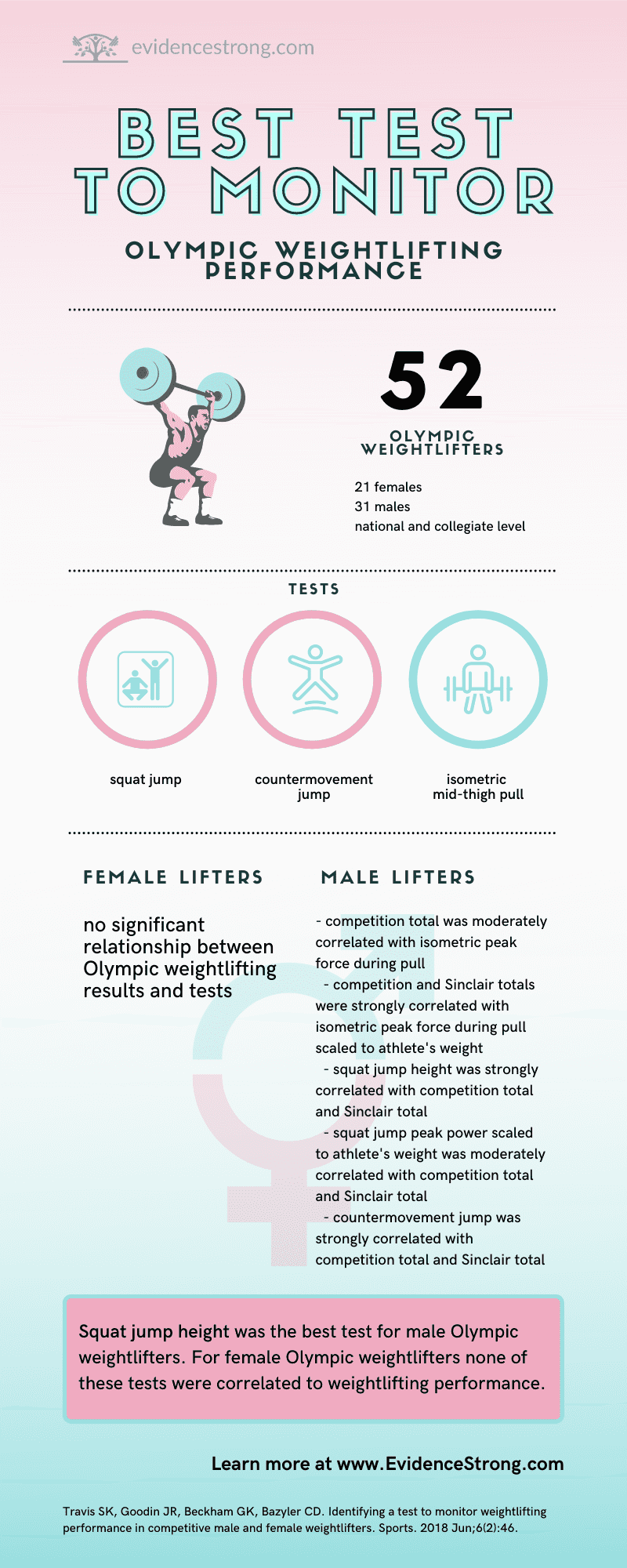Summary of an article comparing jumps and pulls as tests of Olympic weightlifting performance.
Who
52 (21 females, 31 males) national or collegiate level Olympic weightlifters (USA).
Design
Experimental study with retrospective comparison of performance results at 7.0 ± 5.2 days after a competition.
Squat jump
- with a PVC pipe
- starting in the 90° squat position
Countermovement jump
- starting from a self-selected depth
Isometric mid-thigh pull
- with a fixed bar
- knee at 125±5°, hip at 145±5°
Outcome measures
- jump height and peak power:
- in squat jump
- in countermovement jump
- isometric peak force and average rate of force development from 0 to 200 ms during isometric mid-thigh pull
Main results
In females:
- squat jump height was moderately correlated with Sinclair total, but lost significance when correcting for multiple coparisons
- no significant relationship between weightlifting results and jumping and isometric mid-thigh pull tests were found.
In males:
- competition total was moderately correlated with isometric peak force
- competition total was strongly correlated with isometric peak force scaled to athlete’s weight
- Sinclair total was strongly correlated with isometric peak force scaled to athlete’s weight
- squat jump height was strongly correlated with competition total and Sinclair total
- squat jump peak power scaled to athlete’s weight was moderately correlated with competition total and Sinclair total
- countermovement jump was strongly correlated with competition total and Sinclair total
When the tests were compared, squat jump height was the strongest correlate for men (r = 0.686, p ≤ 0.01) and women (r = 0.487, p ≤ 0.05, respectively) with the Sinclair Total compared to countermovement jump height (r = 0.642, p ≤ 0.01; r = 0.413, p = 0.063), isometric mid-thigh pull peak force scaled to body mass (r = 0.542, p ≤ 0.01; r = -0.044, p = 0.851) and rate of force development at 200 ms (r = 0.066, p = 0.723; r = 0.086, p = 0.711).
Take home message
Interview with the author of the original article
Kyle Travis is a scientist specializing in skeletal muscle research with a PhD in Sport Physiology from the University of Florida. Kyle is also a highly qualified strength and conditioning coach with advanced certifications in this field (CSCS,*D, ASCC).
Original article
Travis SK, Goodin JR, Beckham GK, Bazyler CD. Identifying a test to monitor weightlifting performance in competitive male and female weightlifters. Sports. 2018 Jun;6(2):46.

